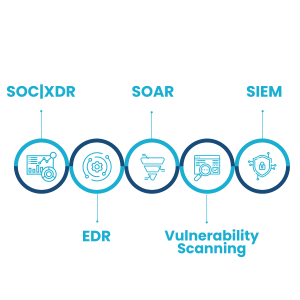Cybersecurity vendor sprawl is an increasingly common situation for organizations of all sizes, and it can be difficult to manage. With each new purchase of a cybersecurity tool, comes the need for more resources and personnel to manage and maintain that platform. This leads to a complex web of vendors, products, and services in an organization’s IT infrastructure. Managing this vendor sprawl is critical for risk mitigation. In this article we will explore how organizations can effectively tackle cybersecurity vendor sprawl.
Identifying & Prioritizing Vendors
The first step in managing your cybersecurity vendor sprawl is identifying your core vendors and prioritizing them according to business value. An effective way to do this is by mapping out your IT landscape with a diagram or flowchart that outlines the different vendors you have used over time, their services, and their security capabilities. This will give you a comprehensive view of which vendors are providing the most value and which ones may be redundant or no longer relevant.
Once you have identified key vendors, prioritize them based on their importance to your business operations and overall risk posed if they were compromised. This will help you focus on where to allocate resources for maintenance and upgrades when needed. Additionally, understanding how vendors interact with each other enables you to better assess the relationship between various systems and identify potential vulnerabilities or areas where one system may rely too heavily on another one; creating a single point of failure if either system fails. Knowing who your key vendors are also allows you to create processes for vetting new partners going forward; ensuring any new partnerships align with your goals while maintaining secure systems and data integrity across all points within your IT landscape.
Tracking & Auditing Vendors
It is essential that organizations track usage data from their various security tools so they can remain aware of any changes in activity levels that might indicate malicious activity. Keeping ongoing records of usage data can help detect security gaps before they become serious issues that require costly repairs down the line. It is important to have records that track usage to help enable your organization to leverage the latest analytics tools and technologies when needed in order to gain deeper insights into user behavior patterns across different platforms and devices. Finally, tracking usage data will allow organizations to audit their system performance against established standards like service level agreements (SLAs) or compliance regulations such as General Data Protection Regulation (GDPR).
Consolidating Cybersecurity Vendors
As a final step, it is important to consolidate your cybersecurity tools and vendors to simplify your security operations. SMBs may be limited in their resources for monitoring and evaluating the security of data flows. Consolidating logs to a SOC-as-a-Service provider can help solve this challenge by bringing on board expertise along with cutting edge AI tools that monitor log activity 24/7, while also alerting you when attention is required. This leaves your team free to devote time and energy into addressing crucial tasks integral to protecting assets – around the clock.
Cybersecurity vendor sprawl has become increasingly common due its reliance on multiple technology solutions, as well as continued acquisitions by larger tech companies who own multiple products or services across many sectors of the market. Selecting the right SOC vendor for your organization’s needs can feel like an overwhelming and challenging task. With so many providers offering individual services in addition to their regular packages, it may be difficult sorting through all of the information to decide which solutions are essential. However, while attempting to consolidate your cybersecurity vendors it’s imperative to find a partner that can provide an all-in-solution. The below graphic shows the AgileBlue Cerulean platform. AgileBlue provides its customers with a cybersecurity tool that includes, SOC|XDR, EDR, SIEM, SOAR and vulnerability management all in one platform.

While it may seem intimidating at first, taking the time now to properly identify core vendors prioritized according to business value, as well as tracking usage data over time and consolidating your vendors can save your organization from costly damage control down the line. By taking proactive steps today towards managing cybersecurity vendor sprawl, your organization can ensure it remains ahead of attackers while keeping customer trust intact through secure networks and systems throughout their IT landscape.
Interested in learning more about the AgileBlue Cerulean platform? Please fill out the form below and a member from our team will contact you shortly.




